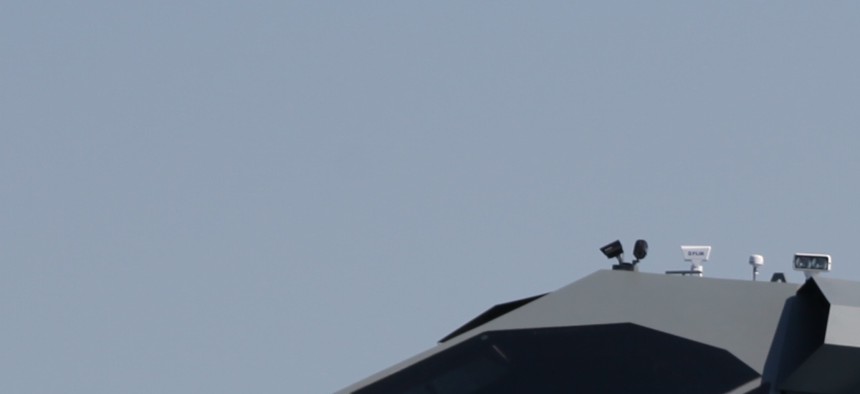
One of Juliet Marine System's GHOST boats in action. Juliet Marine System
This Could Be the Navy SEAL's Boat of Tomorrow
The attack boats of tomorrow could look nothing like those of today. By Patrick Tucker
A boat that water skis on torpedoes could offer a Learjet-like ride for Navy SEAL teams moving into rough enemy waters. It may also prove to be a more stable platform for next-generation weapons systems like the Navy’s direct energy gun (or laser) that target better on stable seas. One day, it could be patrolling the Strait of Hormuz alongside much bigger, more expensive ships. But before that can happen, Juliet Marine Systems, the New Hampshire-based company marketing the system to military, has to make it run faster.
The so-called GHOST boat represents a breakthrough in naval design. There’s no vessel that looks quite this or performs the same way in the water. The diamond-shaped hull sits atop a pair of struts extending to two torpedo-like engines (the makers call these tubular foils.) Together they pull the boat through the water rather than push it from behind via a rudder, which makes it more difficult to detect via radar, hence the “ghost” moniker.
The principle of physics at play here is called supercavitation, which has been an aspect of some torpedo designs since World War II. Cavitation refers to the creation of air or gas bubbles (cavities) in liquid. The bubbles reduce friction as the torpedo moves through the water. “We have a system that draws air down through the center hull through the struts to the tubular foils, up to just behind the propellers. The air is vented out into the water and forms a gaseous layer of air and water between the hull and the surface,” Thomas Richards, Sr. Vice President and Director Juliet Marine and a retired Navy admiral, told Defense One. “Because of that air we get a significant reduction in the drag friction [the hull against the water’s surface.] Using the same basic fuel consumption in the engines.”
Supercavitation made waves of the rhetorical kind this summer when the Chinese government announced that they were working on a supersonic submarine that could travel 6,100 miles per hour using the phenomenon. A trip from Shanghai to San Francisco would take 100 minutes. The reaction to the announcement among military technology watchers in the West was amusement. TIME magazine’s Jeffrey Kluger blithely observed “Despite what China is saying, the submarine’s ‘some day’ isn’t a soon day.”
Supercavitation can move a torpedo at speeds of 200 knots, or 230 miles per hour, the current record held by a Russian supercavitation torpedo called the Shkval. But those speeds aren’t maintainable across distances over a few miles.
Slowness is what’s preventing the GHOST from blasting off. The beautifully designed attack boat of the future can’t go faster than the ones the military has at present. Richards says that the ship today can travel at 30 knots. The company claims that that’s at half its available horse power. They’re hoping to reach 35 in a matter of weeks. The folks he’s talking to in the Pentagon want a boat that can go at least 40 knots per hour, but probably closer to 45 knots for key missions. The company is looking into new engine and propeller designs but it’s all largely unchartered territory.
The second drag is the cost. Coming in at $10 million per unit, according to Richards, the GHOST is more expensive than the Mark V Special Operations Boat (SVO), which is $3.7 million per unit. It’s also far more expensive than the rigid inflatable boats or RIBs that the Navy uses to send SEAL teams into danger zones. But it does provide a better ride experience due to its unique design. “Look at the 11-meter rib,” Richards said. “Try doing 30 knots in 4-foot seas in that. You have to hold on to dear life.”




